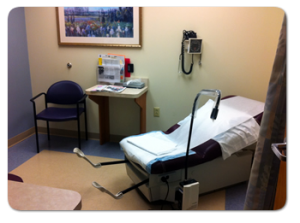History and Physical Exam
During your first visit to our office, your doctor will conduct an interview and consultation followed by a physical exam directed towards your condition (usually involving a pelvic exam). After gaining adequate insight about your concerns, your doctor may recommend specialized testing.

Each of the following diagnostic tests is available through our office:
- CYSTOSCOPY / URETHROSCOPY
- A diagnostic procedure that allows us to look inside of your urethra and bladder using a small lighted scope. Special lenses and mirrors allow us to detect inflammation, stones or tumors of the bladder.
- ULTRASOUND
- A procedure that uses sound waves to study the anal sphincter, bladder, urethra, kidneys, ureters or other pelvic organs. Tumors and other pelvic masses, including abscesses, can be identified using ultrasound techniques.
- URODYNAMIC TESTING
- The name for a variety of tests that require a small catheter to be inserted into the bladder. The tests evaluate lower urinary tract function (bladder and urethra), including storing and emptying urine. These procedures are performed in the office.
- ELECTRODIAGNOSTIC TESTING (EMG) OF THE PELVIC FLOOR
- This testing evaluates nerve function of the pelvic floor. Small adhesive patches applied to various places on the body are used to determine the pelvic floor’s muscle response to a series of small electrical impulses.
- ANAL MANOMETRY
- A test that uses a small catheter within the rectum to determine how well the anal sphincter works.
In addition to these tests the we offer comprehensive, state of the art management of pelvic floor disorders including all surgical and non-surgical options for the treatment of urinary incontinence, pelvic organ prolapse, constipation, and fecal incontinence. For more information regarding the various treatment options available click on our GLOSSARY and FREQUENTLY ASKED QUESTIONS sections.
